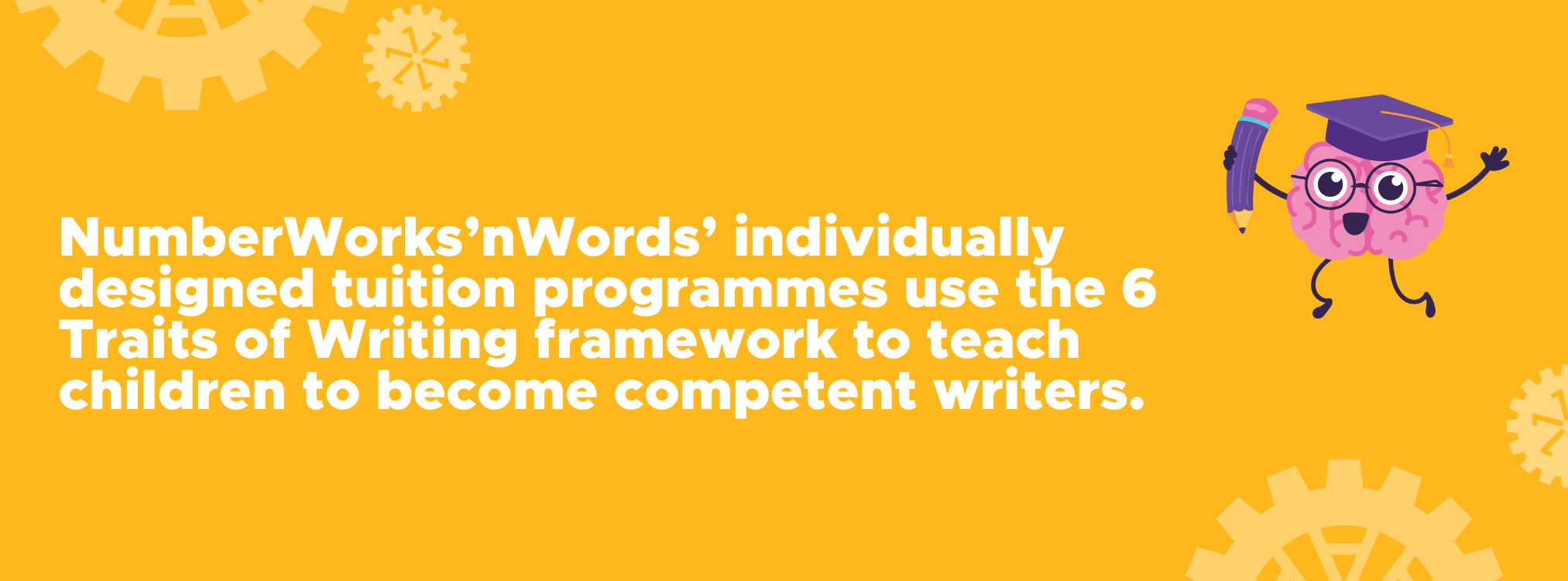The 6 Traits of Writing - A Framework to Master the Art of Writing

Teaching writing is one of the most essential- and challenging - responsibilities educators face. Writing is a complex skill that involves more than just putting words on paper; it requires clear thinking, organised ideas, effective communication, and attention to detail.
The 6 Traits of Writing is a teaching method that takes the guesswork out of learning how to write effectively. It is a framework aligned to a ‘Structured Literacy' philosophy, in that it makes teaching writing systematic, explicit and comprehensive.
Research supports that there are key ‘traits’ found in quality pieces of writing that can be learned - Ideas, Organisation, Voice, Word Choice, Sentence Fluency, and Conventions. These traits are commonly identified as producing good writing, or are the traits that are missing in a piece of writing which is not well crafted. Because the 6 Traits are simply a set of characteristics that are common in well crafted texts of any text type, they also align with all levels and any curriculum.
NumberWorks’nWords’ individually designed tuition programmes use the 6 Traits of Writing framework to teach children to become competent writers. By breaking down writing into manageable components, the targeted instruction offers a clear and effective path to writing success.

How Can These 6 Traits Transform Your Children into Confident, Skilled Writers?
Each trait is taught explicitly as a separate component. By teaching each trait separately in a clear, sequential manner, NumberWorks’nWords is able to build students’ confidence and proficiency in writing. For example, a child learning to generate strong and innovative ideas is not assessed on writing conventions, such as punctuation or grammar. Instead conventions are taught at a later stage.
This discrete approach enables children to refine and hone their skills to achieve mastery of each essential trait. Once instruction in each trait is complete, students then integrate their skills in various writing application exercises.
From young students learning how to craft their first stories, to older students producing persuasive or informative writing pieces, the 6 Traits of Writing empowers learners by providing targeted, effective writing instruction.
1. Ideas: The Foundation of Writing
Ideas are the essence of writing. Teaching students how to generate and develop engaging ideas is the first step in guiding them toward effective writing.
To generate strong ideas, children learn to focus on the following aspects in writing:
- A narrow focus: This means producing a clear main idea that is easy for the reader to identify and follow. Students are taught how to narrow their focus by zooming in on specific aspects of their topic. For example, instead of writing about “animals,” they might focus on “the habits of nocturnal animals.”
- Relevant and interesting details: Details are essential to support the main idea, as well as captivate the reader's attention.
- Writing for a purpose: Writing with a specific purpose in mind—whether to inform, persuade, or entertain—ensures that the writing has direction and intention.
Ultimately, the key question that the Ideas trait addresses is: Does the student's writing clearly present a focused and compelling idea? If the answer is yes, the writing effectively communicates its message and holds the reader's interest.
2. Organisation: Structuring the Writing
The Organisation trait refers to how ideas are arranged and presented in writing. It involves creating a logical flow from beginning to end, ensuring that the reader can follow the writer’s thoughts.
Strategies for teaching Organisation include:
- Grouping like-ideas together
- Sequencing: Ideas should be presented in a consistent and logical order that makes sense to the reader.
- Graphic Organisers: Such as story maps, venn diagrams, or outlines, can be used to help students plan their writing. These tools provide a visual representation of how their ideas will be organised.
- Teaching transitions: Connective or transitioning words such as "first," "next," "however," and "finally", help to link ideas and guide the reader through the text; enhancing the flow and readability.
- Writing introductions and conclusions: A strong introduction will grab the reader’s attention, while a great conclusion leaves a lasting impression.
The key question the Organisation trait must address is: ‘does the writing have a clear structure, with a beginning, middle, and an end?’
3. Voice: Expressing Personality in Writing
The 'Voice' trait in writing is about making the text sound authentic and true to the person who wrote it. It should reflect the writer's personality, making the writing sound like a real person, rather than a generic or mechanical text.
To identify if Voice has been employed effectively in a piece writing, ask yourself: Can you hear the unique style, tone, and personality shine through? When the answer is yes, the writing feels alive, engaging, and distinctly the author's own, making the reader want to keep reading.
How to develop a strong Voice in writing:
- Ensure there is a consistent point of view: This helps readers to connect with the writer's perspective.
- Personal writing: Personal writing allows students to explore and develop their own voice, by encouraging them to write about topics they are passionate about, or that reflect their own experiences.
- Strongly convey mood and emotions: whether these are humorous, serious, reflective, or passionate, use of mood and emotion will draw the reader into the writer's world.
- Use formal or informal Voice: This trait involves finding a balance between formal and informal language and adapting to different contexts, while maintaining personal style and perspective.
- Applying Voice to different genres: For example, the Voice in a persuasive essay might be authoritative and assertive, while the Voice in a narrative might be reflective and descriptive.
4. Word Choice: Selecting the Right Words
Word Choice involves selecting precise, descriptive, and impactful words to convey ideas effectively. Strong word choice enhances the clarity, imagery, and overall quality of writing. Teaching this trait helps students expand their vocabulary and use language more intentionally.
Strategies for teaching Word Choice:
- Varied and precise vocabulary: Students should be challenged to identify words that are vague or overused, such as “nice,” “good,” or “bad.” Then to replace these words with more precise and descriptive alternatives.
- Word Walls: A ‘Word Wall’ that contains vivid, descriptive words is a great prompt for word choices students can use in their writing.
- Imagery (show, don’t tell): This technique makes writing more vivid. For example, instead of writing “The room was messy,” a student might write “Clothes were scattered across the floor, and papers piled up on the desk.”
- Five senses: Students should be encouraged to use specific language that incorporates their senses. For example, “Describe the taste of your favourite food without naming it” encourages students to think critically about word choice.
- Incorporate adverbs to modify verb/adjectives; Encouraging students to use adverbs thoughtfully and effectively, enhances their ability to express ideas vividly and precisely, strengthening their overall word choice in writing.
When assessing word choice, tutors are looking to see if the student took a risk and used juicy words and phrases to paint a picture in the mind of the reader.
5. Sentence Fluency: Creating Rhythm and Flow
When tutoring sentence fluency, the focus is on creating writing that is rhythmic and enjoyable to read aloud, almost like music to the ears. It is one of the easiest traits to assess, as it is achieved by varying sentence beginnings and sentence lengths.
Short sentences can add impact and clarity, while longer sentences can develop more complex ideas and add depth. Together, these elements create a natural cadence and flow, making the writing more engaging and easier to read.
Strategies for teaching Sentence Fluency:
- Read aloud for rhythm: Students should be encouraged to read their writing aloud to hear how it sounds. This helps them identify awkward or choppy sentences and revise for better flow.
- Combining sentences: Students learn how to combine short, choppy sentences into more complex ones.
- Variety in sentence beginnings: Students learn how to vary their sentence beginnings to avoid monotony. For example, instead of starting every sentence with “The,” they might begin with a prepositional phrase or an action verb.
6. Conventions: Mastering the Mechanics
Conventions include the grammar, punctuation, spelling, and formatting that make writing clear and easy to read. While these are often seen as the “rules” of writing, mastering conventions is essential for effective communication. Teaching this trait helps students polish their writing and avoid common errors.
Strategies for Teaching Conventions:
- Mini-lessons on specific skills: At NumberWorks’nWords we focus on one convention at a time, such as comma usage, subject-verb agreement, or proper capitalisation. Mini-lessons teach the rule, and are followed by practice exercises.
- Proofreading and editing: Recognising an error in spelling, punctuation and grammar takes some practice. Reviewing work for different kinds of conventions and correcting these, reinforces children’s understanding of the concepts.
Integrating the 6 Traits: Becoming a More Confident Writer!
The final step is to bring each of the 6 Traits together. Once each trait has been mastered, students at NumberWorks’nWords have plenty of practice integrating all 6 Traits in different kinds of writing. This can happen at various stages of the learning process, depending on a student’s individual tuition needs. For example a student who has mastered two traits may be ready to put their new writing skills into practice to create a new narrative, or develop a persuasive text. Other students may need to build up their confidence in all 6 traits before attempting to integrate their writing skills.
Whether tutoring young children how to craft their first stories, or guiding older students through complex essays, the 6 Traits of Writing framework is a powerful tool for developing students’ writing skills. With consistent practice, encouragement, and guidance, students at NumberWorks’nWords grow into confident, capable writers who can express themselves with clarity and creativity.





